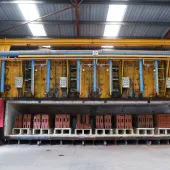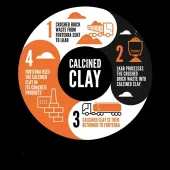First despatch from upgraded Desford factory
Europe’s biggest and most efficient brick factory begins roll-out with delivery to Taylor Wimpey
THE first bricks have now been despatched from Forterra’s new Desford factory in Leicestershire, which is now said to be the biggest and most efficient manufacturing plant in the UK and Europe.
Forterra have invested £95 million in future-proofing the factory in order to achieve outstanding overall equipment effectiveness whilst upgrading production capacity to 185 million bricks per year.
Situated just two miles from the M1 and with excellent transport links, the new Desford site will offer a range of red and buff bricks designed to meet the demands of UK house builders.
For Desford’s first despatch, 23,740 Cheshire Red Multibricks were packed on to trucks from Forterra’s Euro 6 fleet, which uses the ultra-fuel-efficient Volvo I-Save engine to reduce emissions, for delivery to house builders Taylor Wimpey.
Once the Desford factory reaches full operating capacity later this month, it will despatch more than 1,000 packs of bricks per day and produce enough bricks to build 24,000 new homes per year.
Incorporating state-of-the-art innovations with sustainability mechanisms, robotics hardware and advanced packaging solutions, the factory upgrade is set to emit approximately 25% less carbon dioxide per brick than the old factory.
‘With ambitious ESG targets for 2030, we know that sustainability has to be approached holistically, which is why at Desford we’ve incorporated advanced sustainability mechanisms across all aspects of production, packaging, and delivery,’ said Neil Ash, chief executive officer of Forterra.
‘The factory’s impressive production capacity will ensure we can manufacture hundreds of millions of bricks per year using a process that has been streamlined to be efficient and sustainable, while satisfying the ongoing demands of our customers.’
He added: ‘The Desford factory complements several other investments and developments Forterra have made over the past year, such as a solar farm which will render 70% of our power usage electric by 2025; a new eco-fleet of trucks which will reduce our transportation emissions; and new packaging solutions which place us a step closer to our goal of attaining a 50% reduction in single-use plastics by 2025.’










